I discovered the Zero Waste movement, like so many others, when I stumbled on Béa Johnson’s blog, Zero Waste Home. Zero Wasters try to purchase and create as little trash as possible. People like Bea, who really originated the movement, get so good at it they can put all of the trash they generate in a year in a mason jar–everything else is refused, reused,reduced, recycled, or rotted, in that order.
The movement is super inspiring. Paying attention to how much trash you purchase and/or generate gets you thinking about how much waste we, as a society, generate. Zero wasters freely admit that for most people, creating no trash is really hard, if not impossible. The idea is to reduce as much as possible the amount of trash you create, to really think about what you purchase and be creative about ways of buying stuff with less packaging.
The biggest place you can make a difference in the amount of waste you make is at the grocery store.
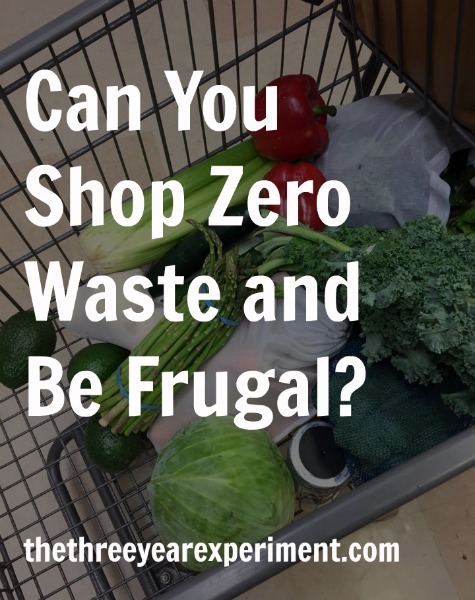
If you choose to buy food without packaging, or ask for your meat and deli items to be put into take-home containers, you can avoid all the plastic packaging many of those items are wrapped in. Zero-wasters bring their own produce bags to the store and many shop in stores that sell in bulk, so they can refill olive oil, peanut butter, and even dish and laundry detergent.
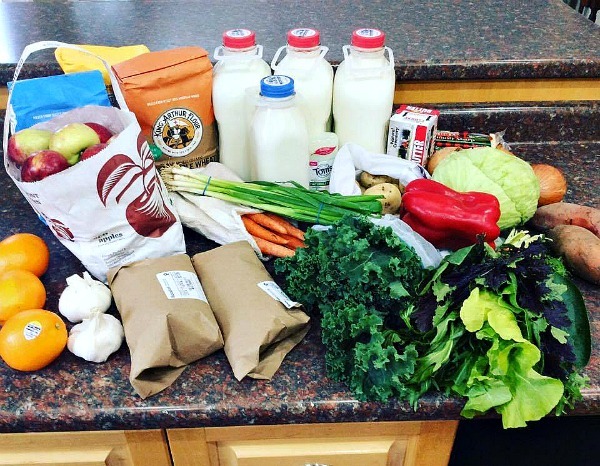
I was excited to try Zero Waste shopping, to see if our family could reduce the amount of trash we produce. But as I’ve gone to the grocery store, and comparison shopped, I realized that grocery stores make it difficult to be Zero Waste and frugal.
A lot of times, the better deal is the fruit or vegetable that’s packaged in the plastic bag. And as a selectively frugal person, whose family is working toward location independence in only three years, it’s hard to pass up the good deal for the better-for-the-environment option, especially when the latter is double the price.
I thought it was time to put my vague, shadowy ideas about Zero Waste Shopping to the test and do a hard line comparison between the items I’d normally buy and their Zero Waste equivalent (if there was one). Then, I could look at the overall cost of Zero Waste Shopping and see if it was considerably higher. If not, I can rest easy, knowing I’m voting for the earth with my shopping dollars while also carefully managing them.
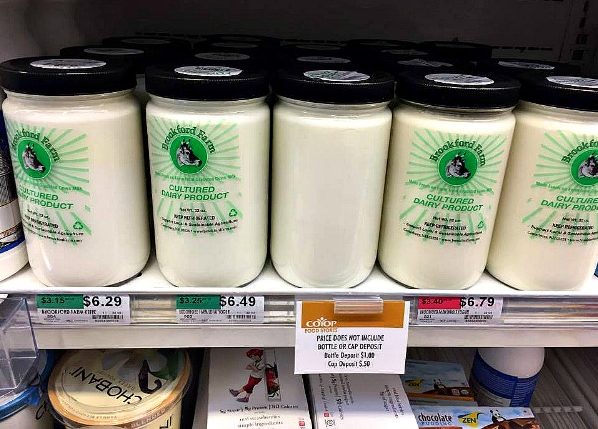
I visited two grocery stores for this comparison. The prices come from Hannaford, a regional chain in the Northeast, and my local co-op grocery store, which sells a lot of items in bulk. I compared prices on items we needed to buy this particular week, which did not include any cleaning items like soap or dish detergent. Most of the items are refrigerator or pantry staples that we buy each week.
One note: Many times on my shopping trip, it was hard to do a one-to-one comparison between items, because the Zero Waste option would be of superior quality–organic, local, or both. So in those instances I’ve tried to find a third product for price comparison, the organic equivalent, so that we’re comparing apples to apples, or, in this case, organic apples to organic apples.
Ok, ready? Here we go!
I started my shopping at Hannaford, my local grocery store (when I say local, I mean that I only have to drive about 25 minutes to get there. Gotta love rural living!).
Produce
My first stop was produce. Fruits and veggies–this should be easy to shop Zero Waste! But wait. The Loss Leaders for the week, clementines and red grapes, were both packaged in plastic bags and no non-packaged alternatives were offered. How frustrating! If you want grapes or clementines, you have to take them in the package, or pick another type of fruit. Luckily, these were the only fruits I found that didn’t have a Zero Waste alternative.
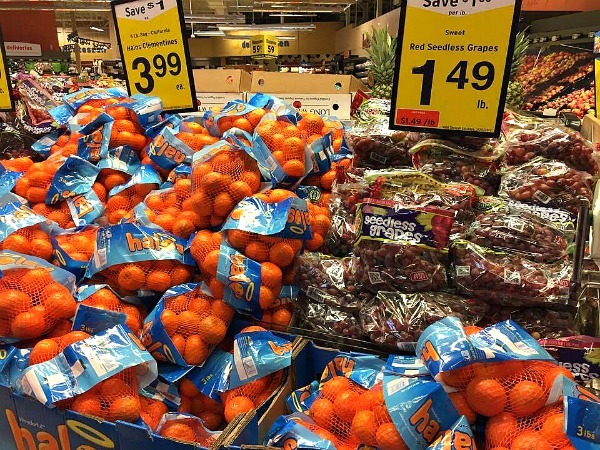
For most of the other fruits and veggies I picked, I noticed that the pricing was similar, although slightly lower, for packaged items. For potatoes, the price was half as much for the bagged potatoes! Zero wasters might pick the potatoes packaged in a bag because you’d be able to compost it. Luckily, potatoes aren’t too expensive anyway, so the double cost didn’t feel quite so painful.
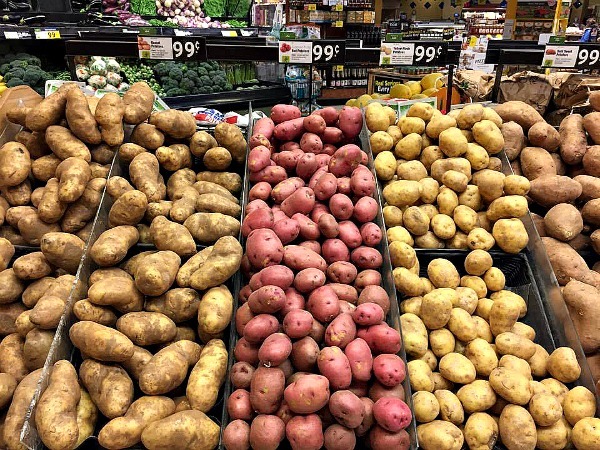
For red peppers it did, though. Why do they have to only sell the cheaper (and more delicious, IMO) red peppers in a plastic bag? The loose peppers are $2.99/lb and the packaged ones are only $2.49/lb. I still chose the loose peppers but only picked two.
I was happy to see that some stalks of celery were being sold package free. I don’t know if they lost some bags, but I chose a stalk without the bag. It was the same price.

At the Bar
At the salad bar, there was a big bin of Parmesan. I took a bunch in my reusable bag. Much cheaper than the kind in the plastic container.
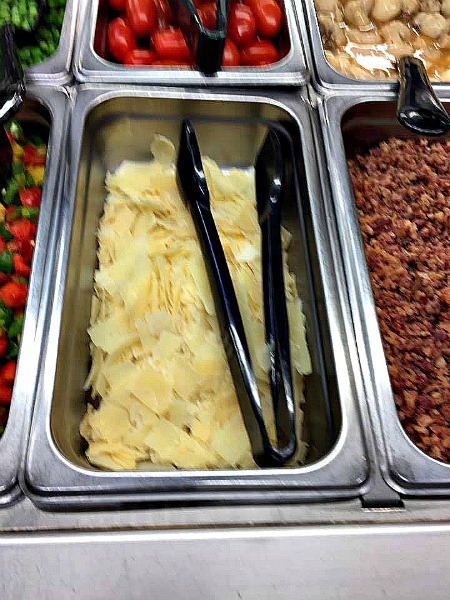
Meats
One of the hardest items to purchase zero waste are meats. Many people get around this by bringing their own reusable containers to the store. I’ve done this before and the meat counter at Hannaford is fantastic–they put my fish or meat in my reusable jar and usually say, “great idea–never thought of that!” The deli counter gives me a hard time, though, and I usually have to argue with them (“No, I’m sure there’s not a law in NH that says you can’t use your own container. Could you ask the manager? I do this all the time…”). It’s really hard to be so counter culture and get a hard time for it, so I stopped bringing in my jars after a few weeks.
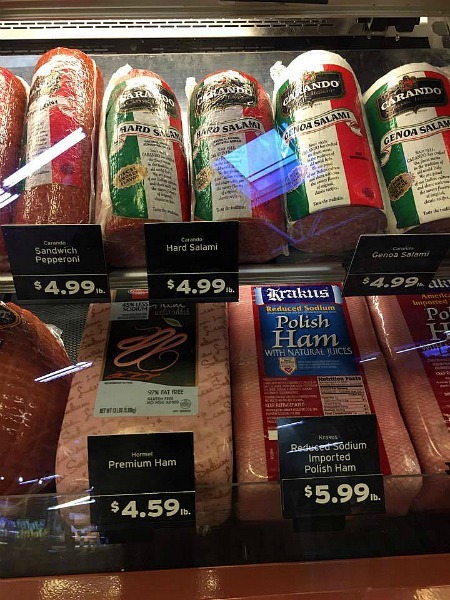
Fish is an easy choice. We only buy fresh fish, sold at the counter, because we make ceviche with it, so if I bring a jar for the fish to go into, it can easily be a Zero Waste choice. Also, there were some very inexpensive seafood options, like mussels, at $2/lb, or littleneck clams, $.60/each.
Other meats sold behind the counter are either slightly more expensive (like ground beef, $5.50/lb versus ) or much more expensive (chicken was almost $6 a pound versus $2.50/lb for the prepackaged option). Many Zero Wasters eat vegetarian, but we’re definitely not so we have to factor in this cost.
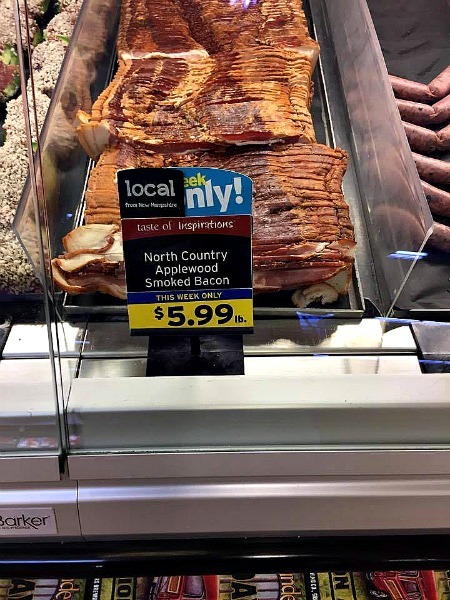
Bacon was $6/lb versus $4/lb, but, it was local, from a smokehouse just down the road, and was actually cheaper than its packaged counterpart, which was $8/lb.
Dairy
For dairy, 18 eggs was $2, but a dozen organic was $5. My colleague at school handily beats this price, at $3 for local, organic, and fresh; I just have to remember to pick them up regularly at school.
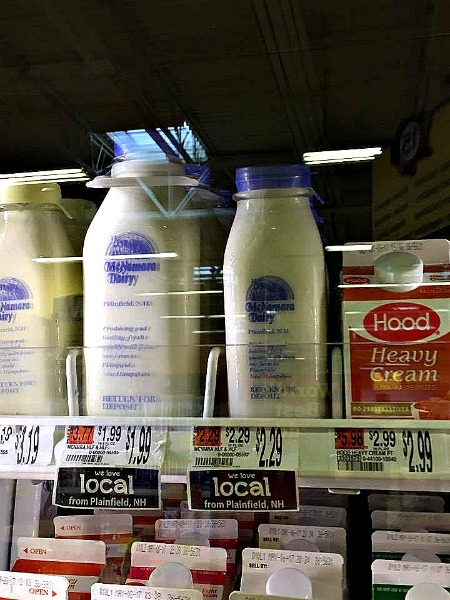
The Zero Waste Half and Half option isn’t bad. It’s exactly the same price as the packaged option, minus the $1 bottle deposit. I call that a wash since it’s a one-time cost. The Zero Waste milk in a bottle is exactly twice as expensive as its non-organic, packaged counterpart. But, it’s cheaper than organic! The Zero-Waste yoghurt was ridiculously expensive. If I chose to forgo the packaged option, we would either have to make our own, or go without. This would be really hard because we love yoghurt. Right now, we buy the plastic bins and recycle them.
Bulk
Now we move on to items that I couldn’t buy at Hannaford. These are items that are sold at the bulk bin at my Co-op. I found a price at Hannaford for comparison, because the everyday Co-op prices are much higher. I had to find organic equivalents for popcorn kernels, almonds, lentils, olive oil, flour, and coffee, because all of these items sold in bulk are organic. Most of the prices between the organic packaged and bulk versions were comparable.
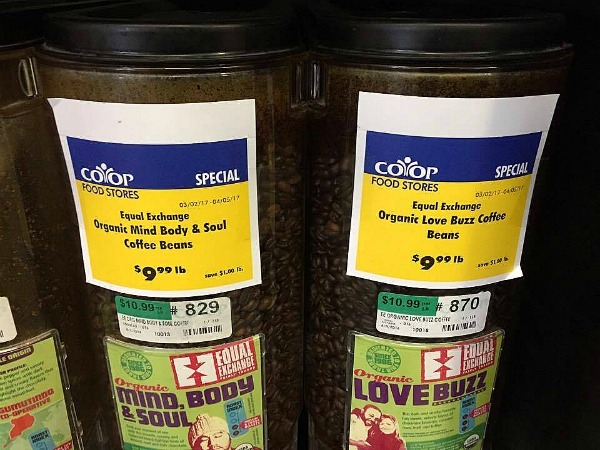
I actually love the bulk aisle at my Co-op. You can get exactly as much as you need. I store it in my glass Bormioli jars, and it makes my pantry look so pretty.
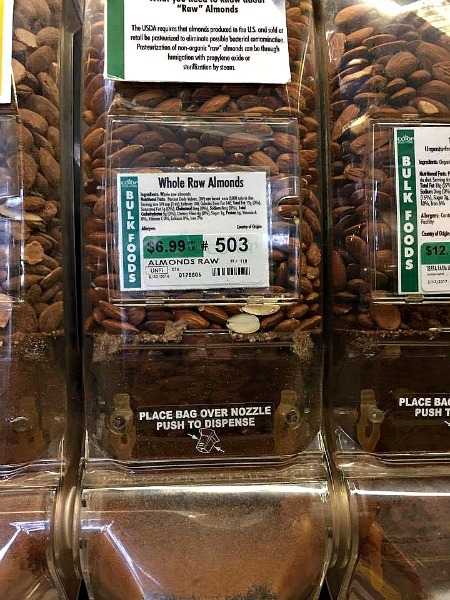
The Grand Totals
| Item | Packaged Cost | Organic, Local, etc. Equivalent, if relevant | Zero Waste Cost |
|---|---|---|---|
| 3 lb. bag of Clementines (ah tasty sweetness) | $3.99 | - | Not available--the only oranges sold loose were blood and navel oranges. Those were roughly $4.14 for 3 lbs. |
| Red seedless grapes | $1.49/lb | - | Not available. Grocery store sayz "you get grapes in a plastic bag or you don't eat grapes, buddy." |
| 3 lb. bag of Granny Smith apples | $2.89 | - | $.99/lb, or $2.97 for 3 lbs. |
| 2 lb. bag of yellow onions | $1.69 | - | $.99/lb, or $1.98 for 2 lbs. |
| Red peppers | $2.49/lb packaged (these are Red Lerouge peppers, only sold in a plastic bag). | - | $2.99/lb not packaged (this one got to me. We love red peppers. $.50/lb higher for the non-packaged option? Really!? |
| 4 lb. bag of yellow potatoes | $2.99 | - | $.99/lb, so $3.96 for 4 lbs. |
| 5 lb. bag of white potatoes | $2.49 | - | $.99/lb, so $4.95 for 5 lbs, or almost double the cost! |
| 3 lb. bag carrots | $1.99 | 2 lbs. for $2.49, so $3.74 for 3 lbs. | $.79/lb, so $2.37 for 3 lbs. |
| Stalk of celery (and wow! They offered both packaged and non-packaged options for the same price! | $1.69 | - | $1.69 |
| garlic | $.79 for two cloves | - | $.69/each, so $1.58 for two cloves |
| broccoli (Not packaged, but rubber-banned. The broccoli crownsweren't, so I considered those the Zero-Waste option | $2.49/bunch | - | $1.69/lb. I got two crowns, so $2.74. |
| Bagged Romaine Lettuce | $2.49 for three heads. But, I estimate that the amount of lettuce in the bag and the amount on the head I bought without packaging was the same. | - | $1.99 |
| Parmesan cheese shavings | $5.69/lb (for the cheapest, shelf-stable option. I wouldn't buy this). | $9.57/lb (this is what I would normally buy) | $5.99/lb (from the salad bar, so there's a limited amount. But this is the clear winner!). |
| Kalamata olives | $8.04/lb in a jar (but vastly inferior to the delicious olive bar olives) | - | $8.99/lb. I'm going to say this is the winner because you can't compare jarred olives to these. |
| Salami | $15.97/lb packaged ($4.99 for 5 oz). | - | $4.99/lb. Also the clear winner! |
| Flour tortillas | $1.79/lb. | - | I make these at home, so the cost of four cups of flour. 1 lb. is two cups, and bulk flour is .69/lb, so $1.38. Winner in cost and taste but NOT in time. |
| Coffee | $3.98 per pound for the cheapest coffee at the store, Cafe Caribe espresso! | $11.99/lb of ethically sourced (but not organic) coffee. $8.65/lb for organic coffee. | $9.99/lb for ethically sourced, organic loose coffee beans |
| Chicken | $2.49/lb packaged | - | $5.99/lb non-packed but marinated |
| Ground beef | $5.09/lb Angus ground beef | - | $5.49/lb lean ground sirloin |
| Bacon | $3.99/lb | $7.99/lb | $5.99/lb local smoked bacon |
| Eggs | $1.99/dozen | $4.69/dozen organic | $3.00/dozen local, organic (from a neighbor) |
| Half and half | $2.29/quart | $4.69/quart organic | $2.29/quart (local dairy, not organic but really close) |
| Milk | $2.69/gallon so $1.35/half gallon | $3.99/half gallon organic | $2.69/half gallon (local, see above) |
| Yogurt | $1.40/lb | $2.00/lb organic | $3.40/lb (local not organic) |
| Lentils | $1.39/lb | didn't have organic option | $2.49/lb organic |
| Rolled oats | $1.52/lb Quaker non-organic | $2.30/lb | $1.19/lb organic (on sale, normally $1.89) |
| Popcorn kernels | $1.06/lb | $2.39/lb packaged organic | $1.99/lb organic |
| almonds | $7.34/lb | $6.99/lb whole raw almonds, $11.49/lb roasted salted | |
| olive oil | $12.85/quart EVOO | $15.98/quart | $12.32/quart organic |
| flour | $.79/lb King Arthur bagged (although if you buy 25 lbs of it, price drops to $.68/lb) | - | $.69/lb King Arthur bulk |
| TOTAL: | Without Organic Option, if I just bought the unit price of everything (minus grapes, since there wasn't an equivalent): $99.92 | If I bought the Organic option when available, regular packaged if not: $131.14 | If I bought everything Zero Waste, not including deposit costs or hassle factor of making things myself: $111.73 |
It’s Official!
So there we have it. The total cost of the normal, packaged trip was $99.92, the Organic packaged options were $131.14, and the Zero Waste trip was $111.73. The packaged option was the winner in terms of price, but the Zero Waste shopping trip was only $11.81 (or 9%) more than the standard packaged trip. However, many of these Zero Waste products are local and/or organic, so it’s probably more fair to compare them to the Organic column. In this case, my trip was actually $19.41 (8.5%) less expensive than buying conventionally packaged and/or organic when available.
This is obviously an imperfect, subjective comparison, for a couple of reasons:
- I tried to only buy items that had a Zero Waste alternative. I avoided condiments, soap, detergent, bread, and other items that are hard or expensive to buy Zero Waste.
- I compared the unit price. I’m obviously going to buy more than one pound of flour, but for the sake of the experiment, I just compared unit price to unit price.
- Some items were skewed because of behaviour changes I’d make. For example, I wouldn’t have bought a pound of uber-expensive packaged salami; I’d have bought a package. I did buy a pound when it was only $4.99/lb, though. So that apples-to-apples comparison is a bit misleading.
- Likewise, if I were buying totally Zero Waste, and only had the very expensive yoghurt option, I would change my buying behavior and not buy yoghurt.
- I ignored the cost of the “Hassle Factor.” For some Zero Waste options, I have to remember to bring cash to school with me to pick up local eggs or I have to spend half an hour in the kitchen making homemade tortillas (they are so good though! My husband won’t let me buy the packaged kind anymore). However, this is a part of frugality, too–making or doing something yourself when you can.
Now that I’ve completed this experiment, I’ve realized that for me, the Zero Waste equivalent is worth the extra cost. It doesn’t affect my bottom line by very much, and I’m almost always getting a superior option when I choose Zero Waste. By shopping with the mindset of eliminating the packaging I purchase, I’m also increasing the quality of groceries I buy for my family.
Since this is real life, let me be honest: I’m still going to continue to buy the clementines, even though they’re packaged, because we love them. I probably won’t bring jars to the meat counter, and I’ll probably still buy my condiments in plastic, rather than glass, because it’s so much easier.
But I am committed to eliminating a lot of the packaging we buy at the store. I’ll recycle everything that’s recyclable, of course. We’ll keep composting our food scraps, so that we create a lot less trash. And we can happily shop Zero Waste, knowing that Zero Waste and frugality are not at odds.
Addendum: Flour Tortilla Recipe
Several readers mentioned they’d like the tortilla recipe I use, so here it is! (I believe this recipe is adapted from Bea Johnson’s book, Zero Waste Home).
Flour Tortillas: makes 12-16
- 3 c. all-purpose flour
- 1 c. whole-wheat flour
- 1 tsp. salt
- 1 tsp. baking powder
- 1 stick cold butter (125 g.)
- 1 c. very warm water
Combine all the dry ingredients. Cut up the butter and squish it into the flour mixture until it becomes crumbly. Add the water and mix well, until all the butter has been combined and you have a well-incorporated dough. Separate into 12-16 small balls. Roll out the dough thinly with a rolling pin. Cook each tortilla in a dry pan over medium heat, about 20 seconds per side.
Tip: Keep your tortillas warm by wrapping them inside a towel on a plate, and leaving them inside your oven set to 200 degrees F (95 degrees C).

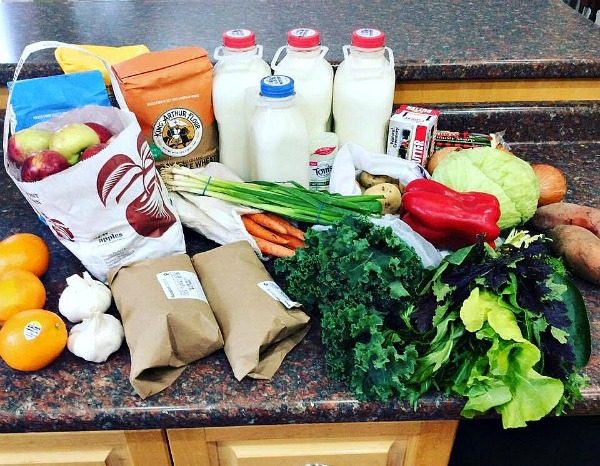

Not going to lie, but I do throw quite a lot of stuff out.
Without a compost, anything that’s too old or rotten gets thrown out. And since I’m trying a new recipe every week, I throw out whatever I don’t like (I’m quite picky about my food).
We threw a ton of food out, too! Wish we were better about buying the perfect amount of food, but we’re not. Starting a compost bin was easier than I thought. It’s a little weird at first if you don’t have a backyard because you need worms, but it works pretty well. A new recipe each week–sounds lovely!
I think I need your tortilla recipe 🙂
Sent! And standby for more recipes, here, soon! 🙂
Good on you!
This is one area where my husband and I really need to do better. So much waste sometimes D:
We’ve even recently somehow misplaced our canvas grocery bags and have an embarrassing amount of plastic around our place. On the plus side, I do use those plastic grocery bags to crochet more bags!
What kind of reusable produce bags do you have, and what was the rough cost?
I have seen people crochet those bags–I love that! So cool!
I have two types of reusable bags–I vastly prefer the cotton ones but the others are cheaper. Here are links from Amazon UK. I paid roughly $5 for the 5 mesh bags and something like $10 for 3 organic cotton ones.
https://www.amazon.co.uk/d/Home-Garden-Store/purifyou-Reusable-Multiple-Polyseter-Children-Equipment-Organizing/B00XSHEJ90/ref=sr_1_1?ie=UTF8&qid=1490870084&sr=8-1-spons&keywords=reusable+produce+bags&psc=1
https://www.amazon.co.uk/Drawstrings-Christmas-Multipurpose-Household-Organizing/dp/B01M307VPH/ref=sr_1_7?ie=UTF8&qid=1490870084&sr=8-7&keywords=reusable+produce+bags
BUT, you’re so good at DIY, I think you’d love the option a lot of Zero Wasters use–find an old sheet and make your own! The cotton is usually the perfect consistency for the bags. I think they just grab a string to make the drawstring.
Good work! If we all commit to buying less packaging, food companies will notice and make it easier for us. Making small changes really adds up and it becomes easier over time. I bring plastic containers for the deli stuff and they just hand it to me and I put it in and put the sticker on the top. I change them over to glass when I get home. Would love your Tortilla recipe too!
That’s a really great idea about the plastic container! I’m going to challenge myself to be brave and bring one in to the store next week! I will add the tortilla recipe to the bottom of the post. 🙂
We’ve gotten really good about recycling – I buy most of our groceries at warehouse clubs (family of five here!) and we have a lot of packaging. The good news is that we recycle almost all of it. We usually fill up two big recycling bins every other week, but our garbage can is mostly empty. One thing I’ve experimented with in prior years was composting. I’d love to get back to that in the summer-maybe I’ll ask for a composting bin for my birthday!
That’s exactly what I did! 🙂 I got a compost bin for my birthday and started really composting in earnest this year. We even composted through the winter! It was actually a lot easier than we thought and I love the bi-product of a less stinky trash can. And this will be the first year we use the compost in the garden, so I’m really looking forward to when we finally get to plant in late May! Good for you for recycling. Yes, I bet your family does go through a lot of food! We’re only four and it amazes me how much we all eat!!
I was going to make a comment that it would be better to become vegetarian in taking up the Zero Waste lifestyle but then saw, “Many Zero Wasters eat vegetarian”. Make sense. And I personally would have no problem with that.
Recently, the child and I helped with a clean up at the beach day. It was definitely a HUGE learning experience for me in that I learned just.how.much.plastic.we.use. It’s really shocking and a major loss for the environment. So since that day, I have been trying very hard to reduce my plastic use. But I’ve come to realize its practically in Everything.
Okay, off to check out about the zero waste home. Nice to have found your blog.
Hi there! So glad you stopped by! Yep, there’s actually a huge “meat eaters” versus “plant eaters” debate in the ZW movement. We’re leaning towards “eating more vegetarian meals than we used to.” I know what you mean about plastic. It’s everywhere!!! Even when you manage to buy things in bulk, you realize they were probably packaged in plastic to get to the store. Good for you and your kiddo for cleaning up the beach! That sounds like an eye-opening experience for both of you. I’m convinced that every bit helps!
Hi Laurie,
Love your concept and your energy – your posts are full of depth and as regular as clockwork! No doubt you will give your three year goal a genuine shake!
Making the right choices at the supermarket does take a little adjustment at first, which is easily solved with patience and mindfulness. And yes, I agree with earlier comments about letting go off meat and even dairy – it is all part of the holistic nature of things and really simplifies your life.
Will be staying in touch with your journey – it’s an inspiration for my family and I – we are seeking a similar goal although three daughters in primary school is one of the challenges right now.
Thank you
Bren
Thanks for the kind words, Bren! I can definitely relate to figuring out what to do with school-aged kids. 🙂 So glad you visited!
Grapes are actually very easy to get zero waste. Sure, they come in plastic bags, but they’re sold by weight and there’s no regulation saying that you have to take their bags.
I bought some grapes without packaging today, actually. I just pulled some clusters of grapes from various plastic bags (not leaving any of the plastic bags empty) and put them in my own mesh produce bag. They weigh them and charge me for them without really even commenting on the fact that I used my own bag. No big deal at all!
Ruth, that’s a great idea. I don’t even think of transferring grapes to my produce bags but of course you could. Thanks for the tip!
I’ve used the same method with buying fresh cherries also.